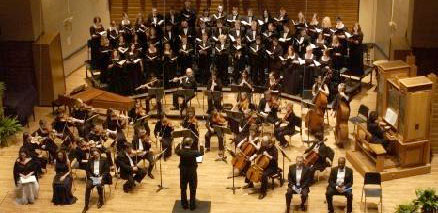by Daniel Hathaway

This year’s featured work was the St. John Passion, but students also got to perform the Magnificat and the cantata Wie schön leuchtet der Morgenstern, BWV 1. Other concerts included solo baroque works played by BW alumni, and music and dance from Paris and London during Bach’s time presented by Catherine Turocy’s New York Baroque Dance Company and (from the opposite coast) Musica Pacifica. The weekend was filled out with lectures, master classes, a period church service and an alumni sing.
This iteration of the Bach Festival also marked a milestone: festival director Dwight Oltman is to retire at the end of the academic year, having served for 39 of its 82 years — just short of half its history.
Because of its educational thrust, the most important aspect of the Bach Festival is the participation of students, who make up the Motet Choir, the Festival Choir (which combines the Motet Choir and the University Chorus), the BW Singers (for the church service), the Brass Choir (which plays preludes — from Marting Tower if the weather gods are smiling — before each big event) and the Bach Orchestra (a combination of faculty principals and students; a separate ensemble, the Festival Orchestra, is made up of faculty and other professionals.)
The choruses, superbly prepared by Dirk Garner, did themselves proud. On Friday evening, the Motet Choir turned in strong performances of Bach’s Wie schön leuchtet der Morgenstern (Garner conducting) and Magnificat (Oltman on the podium) characterized by focused, well-blended tone, crisp diction and rhythmic precision. The Festival Orchestra contributed their own distinguished playing, including the pairs of English horns (Danna Sundet and Siobhan Ball) and horns (Hans Klebsch and Josiah Bullach) that added special ensemble colors to the cantata, and the note-perfect piccolo trumpet section (Chuck Bergink, John Brndiar and David Duro) that crowned climaxes in Magnificat.
Soprano Meredith Hall and tenor Colin Balzer stood out among the professional soloists, and arias were adorned by Danna Sundet’s expressive oboe d’amore solo and Sean Gabriel and Julie Wesolek’s cheerful flute duet. The third Brandenburg concerto, which opened the program, received an energetic performance; Wei-Shu Co supplied an attractive and welcome violin interlude between the fast movements.
On Saturday evening, the Festival Choir and Bach Orchestra took the stage for Bach’s St. John Passion, a fast-moving drama (when it’s not stopping for reflection) that depends on a high level of alertness from the chorus (the crowd), whose sudden outbursts quicken the narrative. They didn’t disappoint, and Oltman generally kept the piece moving along quite effectively. Evangelist Rufus Miller maintained his stamina until very near the end — the last pair of recitatives where all narrators begin to get tired. Soprano Meredith Hall was exemplary in Zerfliße, mein Herze, as was tenor Colin Balzer in the killer aria, Erwäge (Oltman wisely cut most of the da capo).
At the last minute, I decided to watch the Saturday evening performance via the live Internet stream, which offered a basic, wide-angle stage shot with excellent video definition and surprisingly good sound quality. Sitting in a room with adequate light and elbow room made it possible to closely follow the extensive notes in the program book (just over 30 pages).
Bach wrote for pietistic congregations in Leipzig and Melvin Unger’s running commentary falls appropriately in that tradition. But is this a concert or a service? Somewhere puzzling in between, in practice. There’s applause and an intermission where an hour-long sermon would have been preached, but the underlying message is distinctly devotional. It would be interesting, if perhaps heretical, for someone to prepare a true concert version of the piece with judicious cuts of material that bogs it down as a concert work.
Friday afternoon’s opening event featured eight BW alumni in smaller works by Bach, Fasch, Rameau, Handel, Viotti and Manfredini. The artists included tenor Gene Stenger, cellist Heidi Albert, trumpeters Charles Berginc and Lyle Steelman, flutist Sean Gabriel, violinist Michael Keelan and organists Nicole Keller (who also played harpsichord) and William Shaffer. While all the performances were first-class, two pieces stood out for their sheer eccentricity: G.B. Viotti’s Duetto a un for violin solo that sounds like a duet, and Francesco Manfredini’s double trumpet concerto in D, which contains some deliciously sleazy chromatic harmonies.
Saturday afternoon’s performance alternated dance episodes with instrumental pieces from Paris, London — and from Bach, as dancers Catherine Turocy, Sarah Edgar and Justin Coates acted out amusing little drawing room scenes beginning with a mother (Turocy) and her ungainly daughter (Edgar) at a dance lesson taught by Coates. It was all elegant movement combined with lighthearted fun. Pacifica Baroque sounded stylish but a bit pale. A transverse flute instead of the incessant sound of a high recorder would have been welcome.
It will be interesting to see what changes are in the works for Bach Festival 83 in 2015. Parts of the festival will surely remain by dint of tradition, but a lot has changed in Bach performance in the last few decades, only some of which has found its way to Baldwin Wallace.
Published on ClevelandClassical.com May 6, 2014.
Click here for a printable copy of this article.



